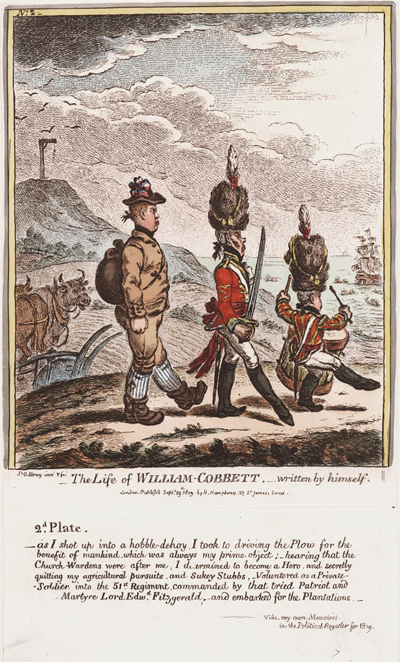The Life of William Cobbett, Written by Himself Pl. 2.
This is the second plate in Gillray's eight plate series, The Life of William Cobbett, Written by Himself which pretends to be a kind of graphic autobiography, but is, in fact a not so veiled attack upon Cobbett himself. For the general context of the series in Gillray's work, some background about Cobbett, and the more immediate impetus for the set of plates, see my Introduction.

© Lewis Walpole Library Yale University
The second plate continues the story of Cobbett's life and the satiric program begun in the first of having Cobbett's own purported words expose more of his character than he intends.
_as I shot up into a hobble-dehoy, I took to driving the Plow for the benefit of mankind, which was always my prime object;_hearing that the Church-Wardens were after me, I determined to become a Hero, and secretly quitting my agricultural pursuits, and Sukey Stubbs,_Voluntered as a Private-Soldier, into the 51st Regiment, commanded by that tried Patriot and [word erased] Martyre Lord Edwd Fitzgerald,_and embarked for the Plantations._ Vide. my own Memoires. in the Political Register for 1809.'
The text and images of this plate are loosely based on passages from The Life and Adventures of Peter Porcupine and from the Political Register of 1809, two of the primary sources of information about Cobbett's life. But they have been distorted or manipulated to create an image of Cobbett and his character that serves the purposes of Gillray and/or his employers.
The reference to quitting his agricultural pursuits and Sukey Stubbs, for instance, probably derives from a story from The Life when Cobbett tried to enlist in the navy, but was dissuaded by a Captain Berkley who mistakenly assumed he was fleeing from a pregnant girlfriend. The Captain warned him that
it was better to be led to church in a halter, to be tied to a girl that I did not like, than to be tied to the gangway, or, as the sailors call it, married to Miss Roper. (Life: 5)
But in Gillray's revisionary history, the Captain's mistaken assumption is presumed as a fact.
The details of Cobbett's military service derive from both the "Life" and the Political Register. Cobbett WAS in fact a member of a regiment commanded by Edward Fitzgerald. But the implication that he specifically chose Fitzgerald's regiment is part of Gillray's satiric fiction. In fact, when Cobbett arrived in Chatham where he enlisted, he thought he had joined the Marines, not the army. (Life: 19) But again, there is satiric reason for implying that Cobbett chose his regiment. In 1809, Lord Edward was infamous as an Irish patriot and British traitor who conspired with the French to invade Ireland in support of an Irish revolution. The tri-colour favour on Cobbett's hat and Cobbett's supposed attachment to Fitzgerald are the first of many indications of Cobbett's revolutionary and reformist inclinations. And it is probably no accident that in marching along with his British recruiters, Cobbett is the only one out of step.
What we are supposed to see here is, I think, a pattern of contradictions, misrepresentations, and betrayals. Cobbett's "prime object," he says, was to drive the plow. But the plow and ox are left in mid-field (to the bewilderment of the ox). He says he joined the army "'determined to become a Hero" but we can see that his hurried decision was prompted by other considerations. One was to escape a looming marriage to the pregnant "Sukey Stubbs." The other was to avoid the Church Wardens who are "after" him. Church Wardens were usually responsible for the parish accounts and expenditures, so the presumption is that Cobbett has been responsible for some kind of theft or breech of trust. The prominence of a gibbet in the background confirms the prophecies of his neighbors in Plate 1 that he will end up on the gallows and reinforces the feeling that whatever it is that he is now running away from, it must be significant.
Sources and Reading
- Commentary from the British Museum on The Life of William Cobbett, Written by Himself Pl. 2..
- Draper Hill, Mr. Gillray The Caricaturist, 1965, p. 117, 144n
- "William Cobbett," Wikipedia
- "Lord Edward FitzGerald," Wikipedia
- The Life and Adventures of Peter Porcupine (1797)
- Cobbett's Weekly Political Register , June 17, 1809
- Thomas Wright and R.H. Evans, Historical and Descriptive Account of the Caricatures of James Gillray #359.
- Thomas Wright and Joseph Grego, The Works of James Gillray, the Caricaturist; With the History of His Life and Times, p. 365-366 .
Comments & Corrections
NOTE: Comments and/or corrections are always appreciated. To make that easier, I have included a form below that you can use. I promise never to share any of the info provided without your express permission.